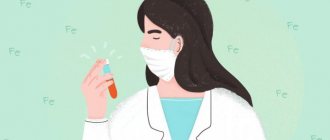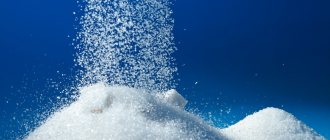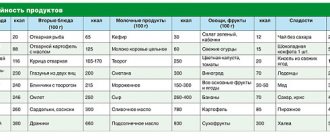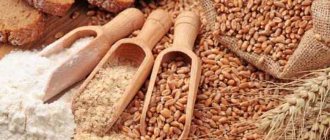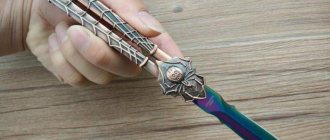Excess weight is not always associated with a predominantly sedentary lifestyle and banal overeating. There are many girls who go to the gym and stick to a diet, but cannot lose weight. The reason for this is often a deficiency of iron, a microelement that has a direct effect on metabolism and thyroid function. If such a problem occurs, the efforts made not only do not produce any results, but, on the contrary, lead to an even greater gain of extra pounds.
Iron is an essential trace element responsible for many important functions for the human body. Its excess and deficiency negatively affect health and well-being. Both conditions are deviations from the norm, but most often people suffer from a deficiency of this microelement.
The role of iron in the human body
The microelement in question is a substance that is responsible for the level of hemoglobin. Iron is an integral part of a huge number of enzymes and performs a large number of important functions:
- transportation of oxygen to tissues, cells, organs;
- hematopoiesis;
- DNA production;
- formation of nerve fibers and growth of the human body;
- maintaining the vital activity of each individual cell;
- ensuring energy metabolism;
- participation in redox reactions.
In addition, the microelement is responsible for the body’s protective functions and other equally important processes. Iron is of particular importance for a woman during pregnancy, since this time is characterized by the maximum need for the substance. Its deficiency leads to very serious adverse consequences.
The body's daily requirement for iron
The normal content of the microelement in the body is from three to four milligrams. The main part of the substance (approximately 2/3) is concentrated in the blood. The remaining concentration of iron is concentrated in the bones, liver, and spleen. A decrease in the level of a microelement occurs for natural reasons - menstrual cycles, sweating, exfoliation of the dermis. If there are no foods rich in iron in the diet, this inevitably leads to a deficiency of the substance, since the spent reserves are simply not replenished. To maintain a microelement at the required level, about 10-30 milligrams of this compound should come from the daily diet.
The exact amount depends on age, gender and other related factors:
- children under 13 years of age - from 7 to 10 mg;
- male adolescents require 10 and female adolescents - 18 mg;
- men - 8 mg;
- women - from 18 to 20, and during pregnancy - at least 60 mg.
Failure to comply with the daily intake of iron leads to disruption of many functions, which even affects appearance. The poor condition of the skin and hair is not always associated with age or incorrectly selected cosmetics. And, when thinking about buying another jar of expensive cream, you should take a closer look at your own diet, since the problem may lie precisely in the lack of iron. This situation is especially relevant for those who often go on diets, wanting to lose weight, limit themselves to eating only some food, paying attention to calorie content, and not to the usefulness of the composition.
Superfood with iron. 3 products for “iron” health
How to drink pomegranate juice with low hemoglobin
Children over one year old are recommended to consume 2 - 3 tsp. pomegranate juice a day. Schoolchildren can drink up to 3 glasses a day, but it is important not to forget to dilute it with water.
To increase hemoglobin when its level in the body is low, it is recommended to drink pomegranate juice according to the following scheme: no more than 1 glass per 30 minutes. before meals 3 times a day for 2 - 3 months. Then you need to take a break, and the course can be repeated again.
It is not difficult to prepare a drink that can increase iron levels in the body, since the fruit itself is quite juicy. From 100 g of grains, on average, 60 ml of natural juice is obtained. There are several ways to cook at home:
- Scroll the peeled pomegranate through a meat grinder.
- Mash the unpeeled fruit thoroughly, trying to keep the peel intact. Then make a hole with a knife and pour out the juice.
- Remove the seeds from the peeled pomegranate, place on cheesecloth and squeeze the juice out of them by hand.
- Cut the fruit into 2 halves and use a juicer.
- Peel the pomegranate and remove the seeds. Use a garlic press to extract the liquid.
Freshly squeezed juice contains the maximum amount of vitamins and nutrients. It is possible to increase hemoglobin levels even with anemia with the help of natural products, and not just medications.
Advice! It is better to drink directly pressed pomegranate juice diluted and through a straw: this is necessary to protect tooth enamel. After use, it is advisable to rinse your mouth with water.
Store-bought pomegranate juice in glass bottles is cheaper, tastes better and lasts longer. But it may contain dyes, preservatives or other additives. The benefits of the drink, if consumed to increase hemoglobin, are thus lost. In addition, when passing through a number of stages of the technological chain, some important substances are also lost.
List of foods high in iron
The microelement is present in various foods, so it can be heme and non-heme. The latter is found in products of plant origin, and the former - of animal origin. The difference between them also concerns the degree of digestibility. Iron from animal products is absorbed by 15-35%, and from plant products by 2-20%. Therefore, the heme microelement should predominate in the diet and be present in sufficient quantities.
Vegetarians have a more difficult time than those who consume meat products daily. The situation can be corrected by eating food that improves the absorption of iron. These foods include those rich in vitamin C.
The greatest amount of iron is found in:
- Meat and offal. These are turkey, chicken, beef, lean pork, lamb and liver. Dark meat contains the most iron.
- Seafood and fish. To compensate for the microelement deficiency, you need to give preference to eating shrimp, tuna, sardines, oysters, clams, mussels, as well as black and red caviar.
- Eggs. This applies to chicken, ostrich, and quail. Along with iron, they contain unsaturated fatty acids, vitamins, and magnesium.
- Bread and cereals. Especially useful are cereals such as oatmeal, buckwheat and barley. Wheat bran and rye contain a lot of iron.
- Legumes, vegetables, herbs. The largest amount of microelement is found in peas, beans, beans, spinach, lentils, cauliflower and broccoli, beets, asparagus, and corn.
- Berries and fruits. In this category of products, the champions in iron content are dogwood, persimmon, dogwood, plum, apples and grants.
- Seeds and nuts. All types of nuts contain many microelements responsible for hemoglobin levels. Seeds are not inferior to them.
- Dried fruits. A large amount of iron is contained in figs, prunes, raisins, and dried apricots.
On a note! Not all dried fruits are healthy.
Often, along with iron, which is valuable for the body, they contain harmful substances. The appearance of fruits that are too beautiful and clean usually indicates that they have been subjected to processing, which allows unscrupulous manufacturers to increase the shelf life of the product.
Table of foods containing iron
A more specific idea of how many milligrams of iron a particular product contains is provided by tabular data. If you analyze the information contained in them, it becomes clear that the highest concentration of microelement per 100 grams of product is found in chicken and pork liver, as well as shellfish. Bran, soy, and lentils are slightly inferior, but the amount of substance absorbed from them is two times lower.
Animal products
| The product's name | Iron content in mg per 100 g |
| pork liver | 20,2 |
| chicken liver | 17,5 |
| beef liver | 6,9 |
| beef heart | 4,8 |
| pork heart | 4,1 |
| beef meat | 3,6 |
| lamb meat | 3,1 |
| pork meat | 1,8 |
| chicken's meat | 1,6 |
| turkey meat | 1,4 |
| oysters | 9,2 |
| mussels | 6,7 |
| sardines | 2,9 |
| black caviar | 2,4 |
| chicken yolk | 6,7 |
| quail yolk | 3,2 |
| beef tongue | 4,1 |
| pork tongue | 3,2 |
| tuna (canned) | 1,4 |
| sardines (canned) | 2,9 |
Products of plant origin
| The product's name | Iron content in mg per 100 g |
| wheat bran | 11,1 |
| buckwheat | 6,7 |
| oatmeal | 3,9 |
| Rye bread | 3,9 |
| soybeans | 9,7 |
| lentils | 11,8 |
| spinach | 2,7 |
| corn | 2,7 |
| peas | 1,5 |
| beet | 1,7 |
| peanut | 4,6 |
| pistachios | 3,9 |
| almond | 3,7 |
| Walnut | 2,9 |
| dogwood | 4,1 |
| persimmon | 2,5 |
| dried apricots | 3,2 |
| dried prunes | 3 |
| pomegranate | 1 |
| apples | 0,1 |
The opinion that grants and apples contain the most iron is not true. Per 100 grams of these fruits there is no more than 1 and 2 milligrams of microelements.
12 vegetables rich in iron
Chemical composition
Pomegranate contains many beneficial substances. It contains as many as 15 amino acids, some of which are essential - the body cannot synthesize them on its own. Pomegranate contains B vitamins: B6, B9, B12, B1, PP (nicotinic acid) - useful for the normal functioning of the nervous system. Pomegranate drink contains vitamin A, potassium, calcium, phosphorus, magnesium, iron.
Contains antioxidants that save cells from peroxidation metabolites. Pomegranate diets are popular among those losing weight - although the benefits of mono-diets are highly questionable. Pomegranate is a good fruit for weight loss and is low in calories. It does not contain cholesterol or fat - it will be useful for people who suffer from problems with the cardiovascular system. Pomegranate contains a lot of vitamin C - ascorbic acid improves iron absorption.
Note! Pomegranate is recommended for vegetarians due to its content of essential amino acids.
Beneficial properties of fruits
What affects iron absorption
Enriching the diet with foods high in microelements does not always compensate for its deficiency in the body. There are foods that interfere with the absorption of the substance. This includes products with polyphenols, calcium and tannin. This fact should definitely be taken into account by those who suffer from iron deficiency.
Dairy products do not contain this microelement, are rich in calcium, and, therefore, lead to a decrease in the substance obtained from food. Strong tea and coffee are not the best allies of iron. Lovers of these drinks should get into the habit of postponing the enjoyment of a cup of invigorating coffee or tea until later after a meal. In general, it is better to replace Coca-Cola with dried fruit compotes or rosehip infusion.
How much pomegranate should you eat to increase hemoglobin?
To increase hemoglobin, you don’t have to drink juice; you can also eat pomegranates. For prevention, doctors recommend consuming 100 g of grains in the morning, before breakfast. But, given that it is not difficult to prepare the juice, it will be more convenient to take it for medicinal purposes to replenish iron and increase hemoglobin levels to normal for several weeks in the form of a drink.
So, an effective remedy for low hemoglobin levels in the body is to eat 1 pomegranate per day. It is necessary to wash the fruit and pass through a meat grinder or food processor. The pomegranate should not be peeled or seeded. To receive the required dose of iron and increase hemoglobin, it is recommended to eat 3-5 tbsp. l. before meals, 3 times a day - for 2 weeks.
How to determine iron deficiency in the body
The lack of this microelement makes itself felt by general weakness, high fatigue, and a sharp decrease in performance. The blush gives way to excessive pallor. The skin becomes rough and excessively dry. The hair starts to come out. Nails peel and break. Cracks form on the heels and corners of the mouth.
A condition in which there is a constant lack of iron is called anemia. It has a negative impact not only on appearance, but also on the body. Examinations often show that even the tissues of the gastrointestinal tract become pale. This indicates insufficient blood supply to this organ, and such a situation is not just a deviation from the norm, but also an indicator that the normal nutrition of the internal organs is disrupted.
Iron deficiency leads to the following problems:
- frequent dizziness;
- general fatigue and weakness;
- rapid heartbeat and shortness of breath even with light exertion;
- numbness of the limbs;
- sleep problems;
- frequent colds and vulnerability to infections;
- disruption of the gastrointestinal tract;
- suppression of appetite and difficulty swallowing food;
- desire to eat chalk or raw cereals, as well as “enjoy” the smell of paint and acetone.
In addition, as noted earlier, the condition of nails, skin and hair deteriorates. In other words, a person’s well-being and appearance leave much to be desired, which negatively affects all aspects. Of course, you can’t diagnose yourself. Only tests can determine that a person is suffering from anemia. Iron deficiency is indicated by a decreased hemoglobin level. In men it should not be lower than 130, and in women it should not be less than 120 grams per 1 liter of blood.
